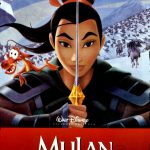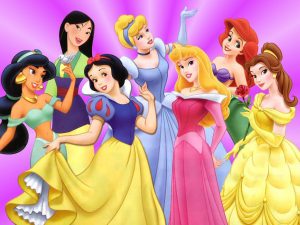Every time we media-oriented feminists start to discuss advertising targeted towards children, or the concept of feminity as it is presented to young girls, many of us have the D-Word on the brain. Disney is the unspoken bad guy for many of us, the embodiment of everything that is wrong with how women are presented in American media.
The standard viewpoint is that The Walt Disney Company systematically produces films with old fashioned and negative depictions of feminity, while its marketing division ruthlessly brainwashes children into blind princess worship. But I think the reality is much more complex. I will concede that Disney is one of the most powerful entertainment conglomerates in operation today. But, I cannot pretend that some of the media they produce doesn’t trouble me. (Their most problematic stuff seems concentrated on the Disney Channel.) And their marketing division is very powerful, effective, and subsequently disquieting.
However, a large part of me has tons of respect for Disney–specifically Disney Animation and the films they produce. I am very passionate about the art of animation and filmmaking, which could slant my perspective, but I don’t think that respect for this largely underappreciated art form is a fault. Disney has some of the most talented artists and storytellers in the world in its employment, and if Disney’s much maligned animated films are examined from a narrative and artistic standpoint, they present more positive feminist messages then often assumed.
A trap that a lot of gender-aware Disney bashers fall into is a lack of historical perspective. I will concede that some of Disney’s earlier films are not exactly beacons of feminism or ethnic diversity. But I’d like to emphasise that Disney’s most clichéd fairy tale narratives were released between 1937 and 1959. In content they reflected not only the social shortcomings of their time, but also the Disney studio’s choice of subject matter. When Disney first started making films, they drew their subjects primarily from European folklore. This was an intelligent decision, because stories like Snow White and Cinderella were well known in the United States and had a built-in appeal for children and adults. The simplicity of fairy tale narratives also allowed the studio more freedom to expand and experiment within the new medium of feature animation. (This means that while some early Disney films may disappoint in terms of compelling female characters and diverse subject matter, the brilliant way they evolved structurally, musically, and emotionally laid the groundwork for more progressive later works.)
 Disney animation, and the art of American feature animation entirely, nearly died during the 1970s and 1980s. But the young animators the company acquired in the 1980s produced a renaissance that brought the studio back to unprecedented artistry in the 90s and, in my opinion, put them on track towards greater gender diversity. Granted, The Little Mermaid, the first triumph of the so –called “Disney Decade” is a low point in terms of female characterisation. (Ariel’s emotional immaturity, blind desire to be with a man she doesn’t know, and inability to speak throughout the majority of the film, is VERY problematic.) But they got on the right track pretty soon after. My personal favorite Disney ladies of the 90s are: Jasmine in Aladdin (1992), Esmeralda in The Hunchback of Notre Dame (1996), and Mulan in Mulan (1999).
Disney animation, and the art of American feature animation entirely, nearly died during the 1970s and 1980s. But the young animators the company acquired in the 1980s produced a renaissance that brought the studio back to unprecedented artistry in the 90s and, in my opinion, put them on track towards greater gender diversity. Granted, The Little Mermaid, the first triumph of the so –called “Disney Decade” is a low point in terms of female characterisation. (Ariel’s emotional immaturity, blind desire to be with a man she doesn’t know, and inability to speak throughout the majority of the film, is VERY problematic.) But they got on the right track pretty soon after. My personal favorite Disney ladies of the 90s are: Jasmine in Aladdin (1992), Esmeralda in The Hunchback of Notre Dame (1996), and Mulan in Mulan (1999).
 Jasmine is a very believable character. She is expressively animated, and she maintains independence, initiative, and a wonderful insightfulness despite her limited exposure to the world and understandable naivety. Esmeralda is very self assured, tough, and smart. She is aware of her position in an oppressed minority, but she fights back, both physically and through social resistance. When she does fall in love in the film, she does it with the air of an adult woman who is making her own personal, emotional decision. She is a well realised female character in a film that maturely deals with themes of racism, classism, sexism and religious intolerance.
Jasmine is a very believable character. She is expressively animated, and she maintains independence, initiative, and a wonderful insightfulness despite her limited exposure to the world and understandable naivety. Esmeralda is very self assured, tough, and smart. She is aware of her position in an oppressed minority, but she fights back, both physically and through social resistance. When she does fall in love in the film, she does it with the air of an adult woman who is making her own personal, emotional decision. She is a well realised female character in a film that maturely deals with themes of racism, classism, sexism and religious intolerance.
And Mulan? I stand by the fact that the film Mulan is about as perfect as a feminist film can get. I saw it four times in theatres when it was first released, and I can pinpoint it as the moment when my little 9-year-old self became a true feminist. Straight from the story’s outset, we get a bitingly satirical song that criticizes marriage oriented culture, strict gender roles, and ideals of feminine beauty. Soon after, Mulan adopts an androgynous and unglamorous look, enters into a male-dominated environment, encounters criticisms of male gender constructions, and more then holds her own. And though a romance is hinted at, the film does not end with a marriage. It maintains that the only happy ending Mulan needs is success, recognition, and the freedom to choose her own role in society.
 Before I saw Mulan, The Little Mermaid was my favorite movie. By the time the summer of 1998 was over, I was practicing that nifty move where she disarms Shan Yu with a paper fan. I was also preaching the need for women to venture into more traditionally male roles to any listening ear.
Before I saw Mulan, The Little Mermaid was my favorite movie. By the time the summer of 1998 was over, I was practicing that nifty move where she disarms Shan Yu with a paper fan. I was also preaching the need for women to venture into more traditionally male roles to any listening ear.
Disney Animation has been pretty consistently gender positive throughout the 2000’s. Stand outs for me include the incredible Lilo and Stitch (2002), and The Princess and the Frog (2009). Both featured independent and complex female protagonists. The latter courted some controversy, and I watched it with a critical eye. My main criticism is that it played it safe rather than directly addressing racism. But I applauded its characters, story, and obvious respect for New Orleans culture. Among its many strengths was the way it directly addressed, and criticised, the class oriented undertones of fairy tale narratives.
I must admit that it upsets me when I see my favorite Disney heroines sanitized into Disney Princess stereotypes. But I try to keep in mind that Disney’s marketing division is often at odds with its artists. (Check out the awesome documentary Waking Sleeping Beauty for some examples.) In fact, my love of Disney’s previous female protagonists actually makes me more critical of what they produce. Contrary to what many assume, I think Disney has set the bar high. Now we can hold everything the company produces not only to our own standards, but to the standards that Disney Animation has set for itself.

Brava Stephanie!!! Very informative and extremely well written. Your blogs are thoughtful and very fair. Good job!